2光子顕微鏡用波長可変フェムト秒Ti:サファイアレーザー
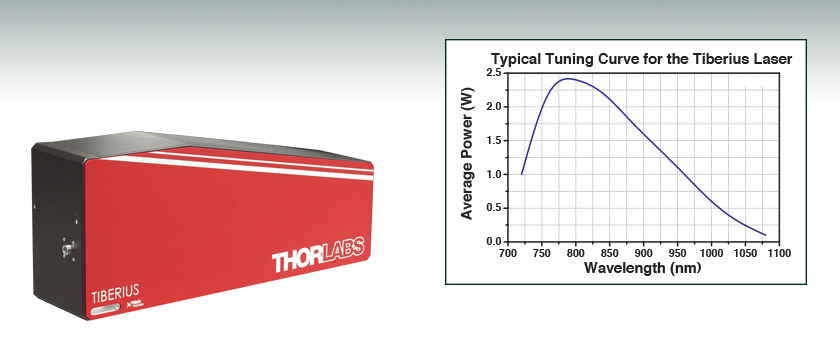
TIBERIUS
Ti:Sapphire Femtosecond Laser,
720 - 1060 nm Tuning Range
- Wide Tuning Range: 720 - 1060 nm
- Fast Tuning: Up to 4000 nm/s
- Half the Footprint of Competing Models

Please Wait
特長
- 720 nm~1060 nmの広いチューニングレンジ
- 業界トップレベルのチューニング速度:最高4000 nm/s
- 高い出力:800 nmで>2.3 W
- 超短パルス:140 fs
- 他社製レーザの半分の設置面積
- 内蔵の分光器によるシステムのリアルタイム診断
- ドライエアーサーキュレーターユニットでレーザ共振器をパージするため、水吸収線によるスムーズなチューニングが可能
主な用途
- 3次元ボリュームのマルチチャンネル蛍光イメージング
- 光刺激およびアンケージング
- 多光子励起による自家蛍光とSHG(第2高調波発生)によるラベルフリーイメージング

Click to Enlarge
Tiberius制御用にGUIが付属
波長可変フェムト秒Ti:サファイアレーザTiberius®は、広いチューニング波長域に渡り140 fsのパルス光を出力し、最高チューニング速度としては業界トップレベルの4000 nm/sを実現しています。当社の多光子イメージングのスペシャリストと共に設計・製造を行った製品は、非線形光学イメージング分野の厳しい要求に対応したハンズフリー操作が可能です。こちらのTi:サファイアレーザの設計・製造に対して、当社の光学設計や精密製造に関する幅広い専門技術をどのように活用しているかについては「設計と製造」のタブをご覧ください。
こちらの2光子顕微鏡用波長可変レーザの平均出力は800 nmにおいて2.3 W以上で、またチューニング波長域も720 nm~1060 nmと広いため、2光子励起蛍光イメージングや光刺激/アンケージングにおいて特定の化合物をターゲットにすることができます。Tiberiusの優れたチューニング速度については「高速チューニング」タブで、チューニング曲線は「仕様」タブでご覧いただけます。
こちらの波長可変Ti:Sapphireレーザのパルス幅は140 fsです。これらのパルスに対して比較的狭いスペクトル幅を選んだ理由は、2光子励起用として高いピーク強度を維持しながら、同時にポッケルスセルやその他の分散素子によるバルスの広がりを抑制するためです。
テーブル面積を有効に活用できるようにTiberiusレーザの共振器は垂直方向に構成されており、光学テーブル上の占有面積は最小限に抑えられています。746.3 mm x 190.0 mmの設置面積は他社製品の約半分であり、他の実験セットアップを置くスペースを確保できます。各レーザには、レーザーコントローラ、励起用半導体レーザーコントローラ、チラー、およびドライエアーサーキュレーターユニットが付属します。
Tiberiusには直感的操作が可能なレーザ操作用のGUIが付属します。ユーザ設定可能なボタンを用いて、ワンクリックでよく使用する励起波長にアクセスできるようになります。 TiberiusはThorImage®LSでサポートされているので、光活性化実験やライブでの高速イメージングにおいてシームレスな同期制御を行うことができます。
2光子イメージングによる構造観察
構造の洞察
多光子顕微鏡には、生体組織が近赤外域光に対する透過窓を有しており、また3次元ボリュームのマルチチャンネル蛍光イメージングを行うための極めて局所的な励起を行うことができるといった利点があります。市販の広視野顕微鏡や共焦点顕微鏡に使用される可視光と比べて、近赤外域光は生体化合物による散乱や吸収が非常に小さいため、より深い部分の画像を得ることができます。
右のハエの目の画像は、形態学的特徴を識別するTiberiusの能力を示しています。この2チャンネルイメージは、GFPで標識された光受容体部分と、多光子励起による自家蛍光を示す標識されていない部分から構成されています。励起波長は770 nmで、Olympus社製の25倍対物レンズ(NA 1.05)を使用しました。
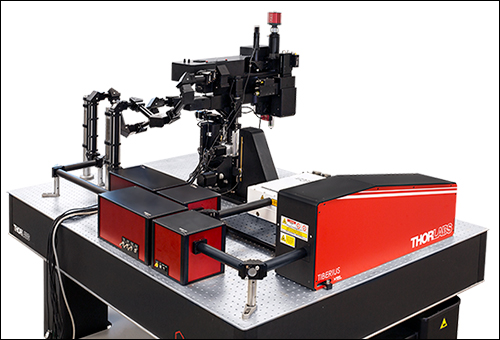
Click to Enlarge
Tiberiusは当社の2光子イメージング用Bergamo IIシリーズ顕微鏡にご使用いただけます。こちらのシステムでは、Tiberiusは同時光刺激と高速イメージングのためのデュアルビームシステムの主レーザとして使用されています。
高速波長チューニングによる画像コントラストの向上
Tiberius®レーザは、業界をリードする最高4000 nm/sの高速チューニング能力を持ち、高速シーケンスイメージングに適しています。Tiberiusの高速チューニングは、2光子顕微鏡イメージングを多色で行う際に、高コントラストの画像を生み出します。
それぞれの色素に適した励起波長に高速で切り替える手法は、単一波長の励起による多色イメージングに比べて様々な利点があります。波長の切り替えはコントラストの向上に寄与し、また低輝度の励起で明るい蛍光が得られるためフォトブリーチングのリスクを低減できます。
図1と2では、試料を2色の蛍光色素でイメージングする際に、高速シーケンスイメージングを行うとコントラストが向上することを示しています。† 試料はラット成体の脳です(厚さ25 µmの矢状断切片)。赤のチャンネルは、835 nmの最適波長で励起されたニワトリ抗ニューロフィラメント抗体の蛍光像で、緑は750 nmの最適波長で励起されたマウス抗GFAP抗体の蛍光像です。図1では、788 nmの単一波長で励起した蛍光像で、2つの蛍光タグの同時励起では最適な像が得られないことを示しています。図2は、750 nmと835 nmの高速チューニング、7 fpsで取得した2色励起イメージングシーケンスの合成画像を示します。こちらの場合では2つの蛍光タグがそれぞれ最適波長で励起されています。
図3の動画では、赤色と緑色蛍光間の高速切り替えを、それぞれリアルタイムと1/16倍の速度でご覧いただけるようになっています。低速時に、各蛍光像の詳細を容易に観察できます。これら2つの画像データセットは、7 fpsのイメージング速度と512 x 512のピクセル分解能で取得しました。Tiberiusの高速波長切替機能はThorImage®LSとシームレスに統合し、同じレーザを使用した光活性化実験の同期制御や、ライブでのミリ秒単位の高速イメージングが可能となります。
†免疫蛍光の試料ご提供:Lynne Holtzclaw of the NICHD Microscopy and Imaging Core Facility, a part of the National Institutes of Health (NIH) in Bethesda, MD
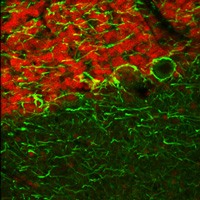
Click to Enlarge
図2. こちらの合成画像では、最適な励起波長750 nmと835 nmの高速切り替えにより高コントラストが得られています。2つのチャンネルセットは7 fpsのイメージング速度で取得しました。†

Click to Enlarge
図1. 上の画像は788 nmの単一波長の励起により取得しましたが、2つの蛍光タグの最適励起波長は750 nmと850 nmです。†
| Specifications | |
|---|---|
| Laser Specifications | |
| Tuning Range | 720 - 1060 nm |
| Pulse Width | 140 fs |
| Average Power | >1.0 W at 720 nm >2.3 W at 800 nm >1.4 W at 920 nm >0.5 W at 1000 nm >0.3 W at 1040 nm |
| Noisea | <0.15% (RMS) |
| Repetition Rate | 77 MHz (Nominal) |
| Beam Diameter (1/e2) | 1.5 mm (Nominal) |
| M2 | <1.2 at 800 nm |
| Pointing Stability During Tuning | <50 µrad per 100 nm |
| Electrical Requirements | |
| Input Voltage | 100 - 240 V |
| Frequency | 50 - 60 Hz |
| Power Consumption | 1.2 kW (Max) |
| Environmental Requirements | |
| Room Temperature | 17 - 25 °C |
| Room Temperature Stability | <3 °C Over 24 Hours |
| Housing Dimensions | 29.38" x 7.48" x 11.32" (746.3 mm x 190.0 mm x 287.4 mm) |
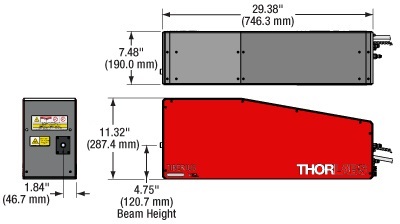
Click to Enlarge
Tiberiusレーザの寸法
本社での製造
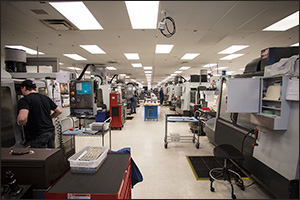
Click to Enlarge
機械工場

Click to Enlarge
超短パルス光学素子用のイオンビームスパッタ(IBS)チャンバ
社内の専門家による設計と製造
Tiberius®は、当社の多分野にわたる経験豊富な設計エンジニアチームと、垂直統合型企業の充実したインフラ基盤によって完全に社内で製造されています。当社のレーザ部門は、Tiberiusの製造、組立ておよび試験における全工程を制御しているため、レーザの安定性と信頼性が保障されています。
このレーザのデザインは、共振器の複雑な理論的シミュレーションと従来型のプロトタイピングを組み合わせた成果です。共振器内のレーザ性能を熟知することで、非線形イメージングに関する特殊なご要望に合わせてレーザを最適化することができています。
精密オプトメカニクス製品製造
Tiberius®の製造には、当社の25年以上にわたる精密フォトニクスコンポーネント製造およびアセンブリの経験が活かされています。例えば、OEMカスタム仕様のニーズや工業用グレード用途に合わせて開発を進めてきた高い性能と安定性を有するPolaris® 設計が最大限に活用されています。この専門的な設計は、熱によるドリフトを抑え、長期的に安定したアライメントを実現しています。
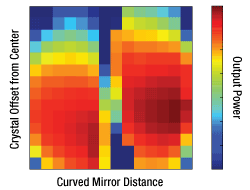
Tiberiusレーザ共振器の2次元数値モデル
当社では、高度に垂直統合された社内システムによって、低価格、高性能のレーザをご提供しています。
最適化された超短パルスレーザ用光学素子
Tiberiusが高い光学性能を発揮するには、レーザ共振器や光学素子を1つのユニットとして最適化することが重要です。光学コーティングは社内で設計され、当社の共振器の独自デザインに精密に調整されるため、多光子顕微鏡に必要な長期安定性と幅広いチューニングレンジを有しています。
このような高性能コーティングを製造するために、あらゆるコーティング方法の中で最も精密な成膜制御と高密度コーティングを実現できるイオンビームスパッタ(IBS)を使用しています。このような特長により、高い損傷閾値を有し、環境要因の影響を受けにくく、ロットごとの性能が安定しているコーティングが実現しました。当社では、Tiberiusの重要な構成部品を製造するために多数のIBS機が稼働しています。
レーザの安全性とクラス分類
レーザを取り扱う際には、安全に関わる器具や装置を適切に取扱い、使用することが重要です。ヒトの目は損傷しやすく、レーザ光のパワーレベルが非常に低い場合でも障害を引き起こします。当社では豊富な種類の安全に関わるアクセサリをご提供しており、そのような事故や負傷のリスクの低減にお使いいただけます。可視域から近赤外域のスペクトルでのレーザ発光がヒトの網膜に損傷を与えうるリスクは極めて高くなります。これはその帯域の光が目の角膜やレンズを透過し、レンズがレーザーエネルギを、網膜上に集束してしまうことがあるためです。
安全な作業および安全に関わるアクセサリ
- クラス3または4のレーザを取り扱う場合は、必ずレーザ用保護メガネを装着してください。
- 当社では、レーザのクラスにかかわらず、安全上無視できないパワーレベルのレーザ光線を取り扱う場合は、ネジ回しなどの金属製の器具が偶然に光の方向を変えて再び目に入ってしまうこともあるので、レーザ用保護メガネを必ずご使用いただくようにお勧めしております。
- 特定の波長に対応するように設計されたレーザ保護眼鏡は、装着者を想定外のレーザ反射から保護するために、レーザ装置付近では常に装着してください。
- レーザ保護眼鏡には、保護機能が有効な波長範囲およびその帯域での最小光学濃度が刻印されています。
- レーザ保護カーテンやレーザー安全保護用布は実験室内での高エネルギーレーザの遮光にご使用いただけます。
- 遮光用マテリアルは、直接光と反射光の両方を実験装置の領域に封じ込めて外に逃しません。
- 当社の筺体システムは、その内部に光学セットアップを収納し、レーザ光を封じ込めて危険性を最小限に抑えます。
- ピグテール付き半導体レーザは、他のファイバに接続、もしくは他のファイバとの接続を外す際には、レーザ出力をOFFにしてください。パワーレベルが10 mW以上の場合には特にご注意ください。
- いかなるビーム光も、テーブルの範囲で終端させる必要があります。また、レーザ使用中には、研究室の扉は必ず閉じていなければなりません。
- レーザ光の高さは、目線の高さに設定しないでください。
- 実験は光学テーブル上で、全てのレーザービームが水平を保って直進するように設定してください。
- ビーム光路の近くで作業する人は、光を反射する不要な装飾品やアクセサリ(指輪、時計など)をはずしてください。
- レンズや他の光学装置が、入射光の一部を、前面や背面で反射する場合がありますのでご注意ください。
- あらゆる作業において、レーザは必要最小限のパワーで動作するようにご留意ください。
- アライメントは、可能な限りレーザの出力パワーを低減して作業を行ってください。
- ビームパワーを抑えるためにビームシャッタや フィルタをお使いください。
- レーザのセットアップの近くや実験室には、適切なレーザ標識やラベルを掲示してください。
- クラス3Rやクラス4のレーザ(安全確保用のインターロックが必要となるレーザーレベルの場合)で作業する場合は、警告灯をご用意ください。
- ビームトラップの代用品としてレーザービュワーカードを使用したりしないでください。
レーザ製品のクラス分け
レーザ製品は、目などの損傷を引き起こす可能性に基づいてクラス分けされています。国際電気標準会議(The International Electrotechnical Commission 「IEC」)は、電気、電子工学技術関連分野の国際規格の策定および普及を行う国際機関で、IEC60825-1は、レーザ製品の安全性を規定するIEC規格です。レーザ製品のクラス分けは下記の通りです
| Class | Description | Warning Label |
|---|---|---|
| 1 | ビーム内観察用の光学機器の使用を含む、通常の条件下での使用において、安全とみなされているクラス。このクラスのレーザ製品は、通常の使用範囲内では、人体被害を及ぼすエネルギーレベルのレーザを発光することがないので、最大許容露光量(MPE)を超えることはありません。このクラス1のレーザ製品には、筐体等を開かない限り、作業者がレーザに露光することがないような、完全に囲われた高出力レーザも含まれます。 |  |
| 1M | クラス1Mのレーザは、安全であるが、望遠鏡や顕微鏡と併用した場合は危険な製品になり得ます。この分類に入る製品からのレーザ光は、直径の大きな光や拡散光を発光し、ビーム径を小さくするために光を集束する光学素子やイメージング用の光学素子を使わない限り、通常はMPEを超えることはありません。しかし、光を再び集光した場合は被害が増大する可能性があるので、このクラスの製品であっても、別の分類となる場合があります。 |  |
| 2 | クラス2のレーザ製品は、その出力が最大1 mWの可視域での連続放射光に限定されます。瞬目反射によって露光が0.25秒までに制限されるので、安全と判断されるクラスです。このクラスの光は、可視域(400~700 nm)に限定されます。 |  |
| 2M | このクラスのレーザ製品のビーム光は、瞬目反射があるので、光学機器を通して見ない限り安全であると分類されています。このクラスは、レーザ光の半径が大きい場合や拡散光にも適用されます。 |  |
| 3R | クラス3Rのレーザ製品は、直接および鏡面反射の観察条件下で危険な可視光および不可視光を発生します。特にレンズ等の光学機器を使用しているときにビームを直接見ると、目が損傷を受ける可能性があります。ビーム内観察が行われなければ、このクラスのレーザ製品は安全とみなされます。このクラスでは、MPE値を超える場合がありますが、被害のリスクレベルが低いクラスです。可視域の連続光のレーザの出力パワーは、このレベルでは5 mWまでとされています。 |  |
| 3B | クラス3Bのレーザは、直接ビームを見た場合に危険なクラスです。拡散反射は通常は有害になることはありませんが、高出力のクラス3Bレーザを使用した場合、有害となる場合もあります。このクラスで装置を安全に操作するには、ビームを直接見る可能性のあるときにレーザ保護眼鏡を装着してください。このクラスのレーザ機器にはキースイッチと安全保護装置を設け、さらにレーザ安全表示を使用し、安全照明がONにならない限りレーザがONにならないようにすることが求められます。Class 3Bの上限に近いパワーを出力するレーザ製品は、やけどを引き起こすおそれもあります。 |  |
| 4 | このクラスのレーザは、皮膚と目の両方に損傷を与える場合があり、これは拡散反射光でも起こりうるとみなされています。このような被害は、ビームが間接的に当たった場合や非鏡面反射でも起こることがあり、艶消し面での反射でも発生することがあります。このレベルのレーザ機器は細心の注意を持って扱われる必要があります。さらに、可燃性の材質を発火させることもあるので、火災のリスクもあるレーザであるとみなされています。クラス4のレーザには、キースイッチと安全保護装置が必要です。 |  |
| 全てのクラス2以上のレーザ機器には、上記が規定する標識以外に、この三角の警告標識が表示されていなければいけません。 |  | |
パルスレーザ:パワーとエネルギーの計算
パルスレーザからの放射光が、使用するデバイスや用途に適合するかどうかを判断する上で、レーザの製造元から提供されていないパラメータを参照しなければならない場合があります。このような場合、一般には入手可能な情報から必要なパラメータを算出することが可能です。次のような場合を含めて、必要な結果を得るには、ピークパルスパワー、平均パワー、パルスエネルギ、その他の関連するパラメータを必要とすることがあります。
- 生物試料を損傷させないように保護する
- フォトディテクタなどのセンサにダメージを与えることなくパルスレーザ光を測定する
- 物質内で蛍光や非線形効果を得るために励起を行う
パルスレーザ光のパラメータは下の図1および表に示します。参照用として、計算式の一覧を以下に示します。資料を ダウンロードしていただくと、これらの計算式のほかに、パルスレーザ光の概要、異なるパラメータ間の関係性、および計算式の適用例がご覧いただけます。
計算式 | ||||
 | and |  | ||
 | ||||
 | ||||
 | ||||
平均パワーから算出するピークパワー、ピークパワーから算出する平均パワー : | ||||
 | and |  | ||
| 平均パワーおよびデューティーサイクルから算出するピークパワー*: | ||||
 | *デューティーサイクル( ) はレーザのパルス光が放射されている時間の割合です。 ) はレーザのパルス光が放射されている時間の割合です。 | |||
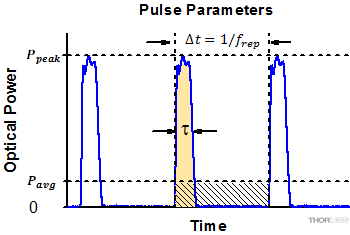
Click to Enlarge
図1: パルスレーザ光の特性を記述するためのパラメータを、上のグラフと下の表に示します。パルスエネルギ (E)は、パルス曲線の下側の黄色の領域の面積に対応します。このパルスエネルギは斜線で表された領域の面積とも一致します。
| パラメータ | シンボル | 単位 | 説明 | ||
|---|---|---|---|---|---|
| パルスエネルギ | E | ジュール[J] | レーザの1周期中に放射される1パルスの全放射エネルギ。 パルスエネルギはグラフの黄色の領域の面積に等しく、 これは斜線部分の面積とも一致します。 | ||
| 周期 | Δt | 秒 [s] | 1つのパルスの開始から次のパルスの開始までの時間 | ||
| 平均パワー | Pavg | ワット[W] | パルスとして放射されたエネルギが、1周期にわたって 均一に広がっていたと仮定したときの、 光パワーの大きさ(光パワー軸上の高さ) | ||
| 瞬時パワー | P | ワット[W] | 特定の時点における光パワー | ||
| ピークパワー | Ppeak | ワット [W] | レーザから出力される最大の瞬時パワー | ||
| パルス幅 |  | 秒 [s] | パルスの開始から終了までの時間。一般的にはパルス形状の 半値全幅(FWHM)を基準にしています。 パルス持続時間とも呼ばれます。 | ||
| 繰り返し周波数 | frep | ヘルツ [Hz] | パルス光が放射される頻度を周波数で表示した量。 周期とは逆数の関係です。 | ||
計算例
下記のパルスレーザ光を測定するのに、最大入力ピークパワーが75 mW
のディテクタを使用するのは安全かどうかを計算してみます。
- 平均パワー: 1 mW
- 繰り返し周波数: 85 MHz
- パルス幅: 10 fs
1パルスあたりのエネルギは、

と低いようですが、ピークパワーは、

となります。このピークパワーはディテクタの
最大入力ピークパワーよりも5桁ほど大きく、
従って、上記のパルスレーザ光を測定するのに
このディテクタを使用するのは安全ではありません。
| Posted Comments: | |
Brian Coop
(posted 2020-07-11 14:51:20.387) The solid model file shows several holes on the bottom of the laser module - can these be used for mounting instead of the clamps? I'd like to mount it up off the surface of the table on posts if that's possible. YLohia
(posted 2020-07-16 01:32:16.0) Hello Brian, thank you for contacting Thorlabs. Four drilled and tapped holes do exist on the bottom of the baseplate as shown in the Solidworks model. That being said, we do not suggest using these for mounting. We strongly recommend that the laser be mounted to a flat breadboard or plate via clamps to ensure even contact with the 3 feet featured on the base of the laser for stability and to avoid unintentional warping or torquing of the laser cavity. We have reached out to you directly to discuss your requirements in more detail. cbrideau
(posted 2016-05-03 17:20:26.28) What are the electrical requirements for the Tiberius including the pump laser? What are the electrical requirements for the chiller? What is the estimated heat load of the entire system? besembeson
(posted 2016-05-05 08:45:25.0) Response from Bweh at Thorlabs USA: The manual has table on electrical requirements: http://www.thorlabs.com/thorcat/TTN/TIBERIUS-Manual.pdf. I will contact you regarding heat load. |
 Products Home
Products Home



























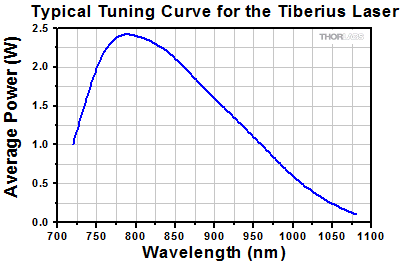
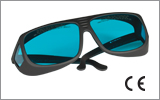
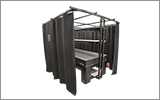
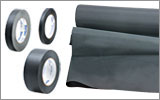
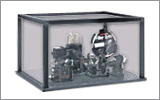
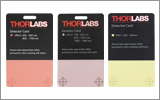
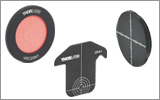
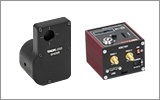
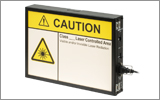
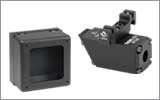

 波長可変Ti:サファイアフェムト秒レーザ、多光子顕微鏡用
波長可変Ti:サファイアフェムト秒レーザ、多光子顕微鏡用